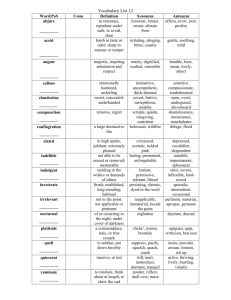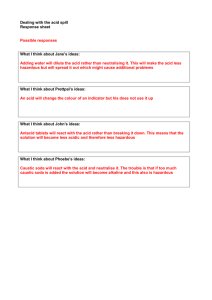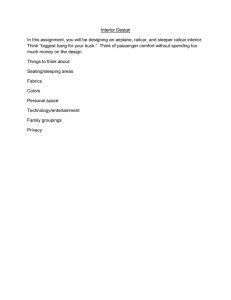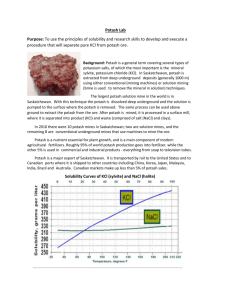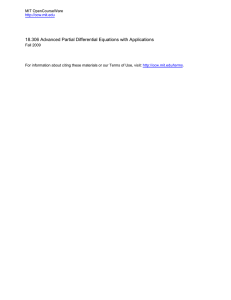Caustic Potash Handbook
advertisement
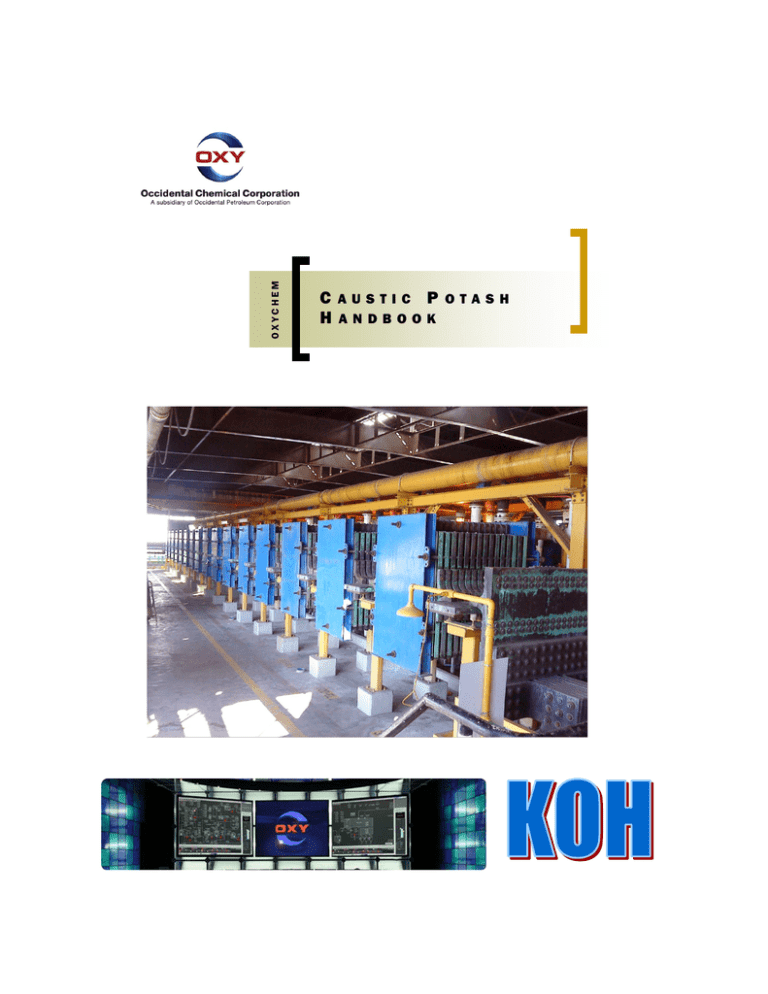
OXYCHEM C H AUSTIC P OTASH ANDBOOK Occidental Chemical Corporation (OxyChem) is a leading North American manufacturer of polyvinyl chloride (PVC) resins, chlorine and caustic soda, key building blocks for a variety of indispensable products such as plastics, pharmaceuticals and water treatment chemicals. Other OxyChem products include caustic potash, chlorinated organics, sodium silicates, chlorinated isocyanurates and calcium chloride. For every product it makes, OxyChem’s market position is No. 1 or No. 2 in the U.S. Based in Dallas, Texas, the company has manufacturing facilities in the United States, Canada and Chile. OxyChem has been an active participant in the American Chemistry Council's Responsible Care® initiative since its inception in 1988. Demonstrating their commitment to attaining the highest levels of safety and environmental achievement, Responsible Care companies implement world-class management systems, measure performance based on industry wide metrics, and are subject to review by independent auditors. Foreword This handbook outlines recommended methods for handling, storing, and using caustic potash. It also includes information on the manufacture, physical properties, safety considerations and analytical methods for testing caustic potash. Additional information and contacts can be found on the internet at www.oxychem.com "IMPORTANT: THE INFORMATION PRESENTED HEREIN, WHILE NOT GUARANTEED, WAS PREPARED BY TECHNICAL PERSONNEL AND IS TRUE AND ACCURATE TO THE BEST OF OUR KNOWLEDGE AS OF SEPTEMBER 2013. NO WARRANTY OF MERCHANTABILITY OR OF FITNESS FOR A PARTICULAR PURPOSE, OR WARRANTY OR GUARANTY OF ANY OTHER KIND, EXPRESS OR IMPLIED, IS MADE REGARDING PURITY, PERFORMANCE, SAFETY, SUITABILITY, STABILITY OR OTHERWISE. THIS INFORMATION IS NOT INTENDED TO BE ALLINCLUSIVE AS TO THE MANNER AND CONDITIONS OF CAUSTIC POTASH USE, HANDLING, STORAGE, DISPOSAL AND OTHER FACTORS THAT MAY INVOLVE OTHER OR ADDITIONAL LEGAL, ENVIRONMENTAL, SAFETY OR PERFORMANCE CONSIDERATIONS, AND OXYCHEM ASSUMES NO LIABILITY WHATSOEVER FOR THE USE OF OR RELIANCE UPON THIS INFORMATION. OXYCHEM DISCLAIMS ANY OBLIGATION TO UPDATE OR CORRECT THE INFORMATION SET FORTH HEREIN. WHILE OUR TECHNICAL PERSONNEL WILL BE HAPPY TO RESPOND TO QUESTIONS, SAFE HANDLING AND USE OF THE PRODUCT REMAINS THE RESPONSIBILITY OF THE CAUSTIC POTASH USER. NO SUGGESTIONS FOR USE ARE INTENDED AS, AND NOTHING HEREIN SHALL BE CONSTRUED AS, A RECOMMENDATION TO INFRINGE ANY EXISTING PATENTS OR TO VIOLATE ANY FEDERAL, STATE, LOCAL OR FOREIGN LAWS." Page 2 of 39 INTRODUCTION Caustic potash (potassium hydroxide or KOH) is most commonly manufactured by the electrolysis of a potassium chloride (KCl) solution. OxyChem manufactures caustic potash using membrane electrolytic cells. OxyChem does not use mercury based electrolytic cells to produce caustic potash. The co-products formed from the electrolytic production of caustic potash are chlorine and hydrogen. The largest users of caustic potash are the soap and detergent, fertilizer, and chemical industries. Minor uses for caustic potash are molten salts, dyes, pharmaceuticals, and photographic chemicals. OxyChem has played a leading role in providing caustic potash to meet the increasing demands of industry. Terminals are used to maintain stocks of our caustic potash in many principal cities. Distributor stocks are also available in these and many other cities and form a network of supply for the end user‟s convenience. Liquid caustic potash is available as a 45% or 50% solution. Caustic potash is also available in dry form as flakes or crystals. Specification sheets for each grade can be found on our website at www.oxychem.com Page 3 of 39 TABLE OF CONTENTS Introduction and Principal Uses 5 Manufacturing 6 Methods of Shipping Caustic Potash 8 Safe Handling of Caustic Potash 9 Unloading Caustic Potash 12 Equipment for Handling Caustic Potash 22 Technical Data 26 Methods of Analysis 37 Page 4 of 39 PRINCIPAL USES AND CONSUMPTION OF CAUSTIC POTASH Caustic potash is one of the very few chemicals utilized in a very broad range of applications. Some principal products or processes in which caustic potash is used are: Dehydrating agent for drying gases A lubricant in the extrusion pressing of high melting alloys A scavenger in gasoline treating process (dual layer) for removing mercaptans A methylating agent An alkaline builder in detergent formulations In refining petroleum fractions In removing insulating coatings from wire In purifying olefin feedstock In stabilizing synthetic lubricants In removing naphthenic acids from natural gas In fertilizers In descaling ferrous metals In sweetening sour petroleum fractions In a fused alkaline salt mixture used for metal cleaning In lye peeling In electrolytic stripping baths In chemical compounding In a molten bath for removing polyesters and polyurethanes from steel objects As a chemical desiccant As an agent for lowering the sulfur content of coal In alkaline batteries As a catalyst for biodiesel production Page 5 of 39 MANUFACTURING PROCESS Caustic potash is produced by OxyChem by an electrolytic process as shown in the following diagram. Brine, prepared from potassium chloride (KCl), is electrolyzed in a membrane cell. The production of caustic potash (KOH) also results in the co-products of chlorine and hydrogen. In the membrane process, a solution of approximately 32% strength is formed. The solution is then sent to evaporators, which concentrate it to a strength of 45% or 50% by removing the appropriate amount of water. The caustic potash solution is inventoried in storage tanks prior to shipment. The product is shipped via tank trucks, railcars, barges and ships. The dry form of caustic potash ships in drums, supersacks and plastic bags. OxyChem‟s caustic potash (potassium hydroxide) meets the test requirements specified in the Food Chemicals Codex (FCC), Eighth Edition, 2012. However, caustic potash is not produced under all cGMP (current Good Manufacturing Practices) requirements as defined by the FDA (Food & Drug Administration). OxyChem does not represent or warrant general compliance of this product for food use. Each prospective use of a product in a food or food related application must be carefully assessed against appropriate regulations by the user and it cannot be assumed that products meeting FCC test requirements are satisfactory for all uses without such assessment. MEMBRANE CELL Page 6 of 39 MANUFACTURING PROCESS Page 7 of 39 SHIPPING METHODS Liquid caustic potash is available from OxyChem‟s plant and terminals in tank truck, rail car, barge and ship quantities. Each form of transportation has its own advantages. The type of shipping method selected will depend upon such factors as size and location of storage, rate of consumption, plant location, freight rates, etc. Anhydrous caustic potash is marketed in flake and crystal form. Drum packages include sizes of 100, 400 and 450 pounds. Both flake and crystal forms are also available in bulk 2000 pound supersacks. The flake form is available in 50 pound bags. Caustic potash is regulated by the U.S. Department of Transportation (DOT) and is classified as a corrosive material. The DOT identification number is UN 1814 for liquid and UN 1813 for dry caustic potash. Page 8 of 39 SAFELY HANDLING CAUSTIC POTASH Caustic potash in any form or concentration must be respected by everyone who handles and uses it. Before starting to work with it, the user should be aware of its properties, know what safety precautions to follow, and know how to react in case of contact. Accidental exposure to caustic potash may occur under several conditions. Potentially hazardous situations include handling and packaging operations, equipment cleaning and repair, decontamination following spills and equipment failures. Employees who may be subject to such exposure must be provided with proper personal protective equipment and trained in its use. Some general guidelines follow. Read and understand the latest Safety Data Sheet. Provide eyewash fountains and safety showers in all areas where caustic potash is used or handled. Any caustic potash burn may be serious. DO NOT use any kind of neutralizing solution, particularly in the eyes, without direction by a physician. Move the patient to a hospital emergency room immediately after first aid measures are applied. FIRST AID MEASURES Please consult OxyChem’s latest Safety Data Sheet for caustic potash found online at www.oxychem.com for the latest first aid measures. Page 9 of 39 SAFELY HANDLING CAUSTIC POTASH PERSONAL PROTECTIVE EQUIPMENT OSHA requires employers to supply suitable protective equipment for employees. When handling caustic potash, the following protective equipment is recommended: Wear suitable chemical splash goggles for eye protection during the handling of caustic potash in any concentration. The goggles should be close fitting and provide adequate ventilation to prevent fogging, without allowing entry of liquids. The use of a face shield may be appropriate when splashing can occur, including loading and unloading operations. Wear rubber gloves or gloves coated with rubber, synthetic elastomers, PVC, or other plastics to protect the hands while handling caustic potash. Gloves should be long enough to come well above the wrist. Sleeves should be positioned over the glove. Caustic potash causes leather to disintegrate quite rapidly. For this reason, wear rubber boots. Wear the bottoms of trouser legs outside the boots. DO NOT tuck trouser legs into boots. Wear chemical resistant clothing for protection of the body. Impregnated vinyl or rubber suits are recommended. Wear hard hats for protection of the head, face and neck. If exposures are expected to exceed accepted regulatory limits or if respiratory discomfort is experienced use a NIOSH approved air purifying respirator with high efficiency dust and mist filters. PROTECTIVE PRACTICES Keep equipment clean by immediately washing off any spill or accumulation of caustic potash. Weld pipelines where practical. Use flanged joints with gaskets made of caustic potash resistant material such as rubber, PTFE, or EPDM rubber. If a screwed fitting is used, apply Teflon® tape to the threads. When disconnecting equipment for repairs, first verify that there is no internal pressure on the equipment and that the equipment has been drained and washed. Provide storage tanks with suitable overflow pipes. Overflow pipes should be directed to a protected overflow area away from operations Shield the seal area of pumps to prevent spraying of caustic solutions in the event of a leak. When releasing air pressure from a pressurized system, take every precaution to avoid spurts or sprays of caustic solution. Page 10 of 39 SAFELY HANDLING CAUSTIC POTASH In case of a spill or leak, stop the leak as soon as possible. After containment, collect the spilled material and transfer to a chemical waste area. Remove large liquid spills by vacuum truck. Neutralize residue with dilute acid. Flush spill area with water and follow with a liberal covering of sodium bicarbonate or other acceptable drying agent. HANDLING LIQUID CAUSTIC POTASH In handling caustic potash solutions, care must be taken to avoid solidification which will plug pipelines and equipment. Chart 1 shows the freezing points for solutions of caustic potash at various concentrations. Should a caustic potash solution become frozen in process equipment or piping, care must be taken when thawing the material. The use of atmospheric pressure steam is suggested. Accelerated corrosion can occur in areas where equipment is subjected to extremely high temperatures. HANDLING ANHYDROUS CAUSTIC POTASH Extreme care must be exercised when adding anhydrous caustic potash to water or to a solution. Its high heat of solution generates large amounts of heat which can cause local boiling or spurting. When making solutions always add the caustic potash slowly to the water surface with constant stirring. Never add the water to the caustic potash. Anhydrous caustic potash will dissolve freely in a well agitated solution under proper conditions. Without agitation, the anhydrous caustic potash will fall to the bottom and form a layer of hydrate which dissolves quite slowly. Page 11 of 39 UNLOADING AND HANDLING CAUSTIC POTASH IN RAILCARS GENERAL INFORMATION Liquid caustic potash has a markedly corrosive action on all body tissue. Even dilute solutions may have a destructive effect on tissue after prolonged contact. Inhalation of mists can cause damage to the upper respiratory tract, while ingestion of liquid caustic potash can cause severe damage to the mucous membranes or other tissues where contact is made. It is important that those who handle caustic potash are aware of its corrosive properties and know what precautions to take. In case of accidental exposure, immediately flush the exposed area with large amounts of water and seek medical attention. For more specific information refer to the Safety in Handling Caustic Potash section of this handbook and in the OxyChem SDS for Caustic Potash liquid. PLACEMENT OF THE RAILCAR FOR UNLOADING 1. After the car is at the loading spot, DOT regulations require that the hand brake be set and the wheels blocked (chocks). 2. DOT regulations require caution sign(s) be placed on or next to the rail track to warn persons approaching the car from the access track end(s). Caution signs must be left up until the railcar is completely unloaded and disconnected from the customer‟s connections. Signs must be made of metal or other suitable material, at least 12x15 inches in size, and bear the words, “STOP-TANK CAR CONNECTED”, or “STOP-MEN AT WORK.” 3. It is recommended that a locked switch or derail device be placed at the access track end(s), a minimum of one car length away from the railcar to be unloaded. 4. A railcar of caustic potash should only be unloaded when adequate lighting is available. 5. A suitable ramp should be used to access the railcar top operating or safety platform. The access ramp chosen should accommodate a variety of platform widths because of variations in rail car manufacturers, and railcar heights since the railcar will rise while unloading. UNLOADING PRECAUTIONS Before making any connections, verify the content of the railcar is caustic potash. Test the nearest eyewash and safety shower per your facility procedure. Only responsible and properly trained personnel should unload liquid caustic potash. Unloading operations must be monitored while the car is connected. Page 12 of 39 UNLOADING AND HANDLING CAUSTIC POTASH IN RAILCARS Since serious burns can result from contact of caustic potash with the eyes and skin, the following personal protective equipment (PPE) is recommended when handling equipment for caustic potash. Based on a job task analysis or job hazard assessment more PPE may be appropriate. Hard hat Mono-goggles Face shield Rubber, steel-toed boots Chemical gloves Chemical resistant suit Respiratory protection Make certain that the storage tank is vented and has sufficient room available for the contents of the entire railcar. Consider restricting access to the area around the railcar and transfer line to the storage during the actual transfer operation. If a railcar needs to be moved when partially unloaded, DOT regulations require that all unloading lines must be disconnected and railcar closures must be replaced. A railcar may be sampled either from the top manway, or from the top eductor line using a suitable procedure. Sampling from the bottom unload piping is not recommended. If a railcar has partially frozen and has been thawed, special sampling techniques may be required due to stratified concentrations that may be present. OxyChem‟s liquid caustic potash is shipped in insulated and lined railcars. Typical linings have an upper temperature limit of 225°F. Therefore, recommended „trapped steam‟ pressure used in the coils to heat up a rail railcar is limited to 15 psig max. Most customers use atmospheric steam in the coils. Unloading lines should be insulated and heated when used to transfer liquid caustic potash to storage in cold climates. The preferred method of heating is to provide electric or steam heat tracing around the unloading line, under the insulation. An alternate method is to provide tees in the unloading line so that steam (or hot water) can be run through the unloading line just prior to its use. Use caution using this method so as to NOT put water or steam directly into the railcar of caustic potash. NOTE: Running steam through unlined steel piping systems can result in increased corrosion and iron pickup in the product. A properly designed and equipped padding system must be used if the railcar will be pad pressure unloaded. Compressed air is the most common padding gas. Nitrogen can also be used but it is more costly, and it has the additional hazard of being an asphyxiant gas, thus extra precautions are required. It is important that all fittings used for padding a railcar be inspected for defects before each use. The air supply system should be oil free, and have a pressure relief valve set at 25 psig, and a pressure regulator set at 18 to 20 psig. The removable connection piping used on the railcar 1” air valve should also have a pressure gauge, a release (vent) valve and a shut-off valve. Page 13 of 39 UNLOADING AND HANDLING CAUSTIC POTASH IN RAILCARS General purpose caustic railcars are constructed to a 100 psig design, and have a burst rating of approximately 500 psig. Per 49 CFR 179.15 caustic railcars can have a pressure relief device installed that is set for 75 to 165 psig. The lower rated relief devices are sometimes hydraulically activated during rough transport handling, and can release some liquid onto the jacket area. Even though they are designed and equipped as stated, these are NOT pressure railcars and should not be padded above the OxyChem and the Chlorine Institute recommended range of 20 to 25 psig max. At OxyChem after a railcar is loaded with product, it is padded up to approximately 30 psig and leak checked to meet the DOT shipping requirement. That test pad pressure is released prior to shipping. Because of inherent shaking and jarring experienced by the railcar and contents during the shipping process, gaskets and joints can loosen up and customers should be cautious of that possibility. If pressure unloading, particular areas to watch are the manway gasket, the bottom flange gasket (when bottom unloading), and the top operator stuffing box gland area for the bottom outlet valve (BOV) if so equipped. Additionally the top operated bottom outlet valve reach rods can in rare instances, come detached during transit. There have been reports that these detached rods can be pushed up from a railcar if unloading pressures greater than 30 psig are used HANDLING IN COLD WEATHER Since OxyChem tank cars are well insulated and liquid caustic potash is loaded hot (~100F ), product usually arrives at its destination in a liquid state. However, since 50% liquid caustic potash begins to crystallize at 40°F, in cases of unusual delays in transit, partial freezing may take place in cold weather. A temperature measurement of the caustic potash is the best indication if steaming is required. If the railcar product is 70°F or cooler, heating is recommended prior to unloading. Even in a liquid phase, cold material may flow poorly due to its higher viscosity. If a railcar temperature is over 65°F but product will not flow from the BOV (bottom unloading), try applying a steam lance for a few minutes to the BOV and 2” aux valve piping area. This uninsulated piping area is prone to freezing. If freezing has occurred, the following procedure should be used: 1. Vent the railcar – OxyChem recommends customers open the railcar manway cover. Alternatively, one can open the 1” air vent valve but one must insure it is clear and open. 2. Connect a steam line to the bottom jacket connection pipe, and/or at the BOV connection. Connect a condensate return line at the steam condensate outlet pipe. If a steam trap is used on the exit of a railcar, OxyChem recommends regulating the steam pressure into the coils to 15 psig MAX. This is to protect the lining from excessive spot heating, which will damage the lining. If a condensate return line is not used, it is advisable to direct the condensate to the ground or to a sewer, adhering to local environmental regulations. Page 14 of 39 UNLOADING AND HANDLING CAUSTIC POTASH IN RAILCARS The amount of material that is frozen in a caustic potash rail car is dependent upon the outside temperature, wind chill, and the time elapsed between when the railcar was loaded and is unloaded. In very cold winter conditions, it is possible for a caustic potash railcar to be totally frozen. For this case, it may be necessary to steam the rail car for as long as three days (72+ hours) to fully liquefy all of the contents. A temperature measurement is the best indication as to when the contents have liquefied and the caustic potash is ready for unloading. The recommended minimum unloading temperature of 50% caustic potash is 70° F. At 70° F through 90° F steaming may be desirable to reduce viscosity. If the above measures do not liquefy the contents on the railcar, contact your OxyChem technical representative. NOTES: Do not exceed a steam pressure of 15 psig on the jacket. Certain railcar linings can be damaged using steam pressure above15 psig. Do not keep steam on while emptying the railcar. Exposing the steam coils without fluid present to dissipate the heat can damage the lining due to local heating. Do not heat the product over 120oF to minimize corrosion of unlined steel piping systems and equipment. Page 15 of 39 UNLOADING AND HANDLING CAUSTIC POTASH IN RAILCARS Page 16 of 39 UNLOADING AND HANDLING CAUSTIC POTASH IN RAILCARS UNLOADING RAILCARS Rail cars can be either bottom unloaded via the BOV - using gravity or pad pressure, or top unloaded through the well line using pad pressure. Refer to Figure 2 for the various unloading arrangements present on a caustic railcar. BOTTOM UNLOADING - GRAVITY 1. Verify the contents are liquid and at the desired unloading temperature. If not, see “Handling in Cold Weather.” 2. Vent the railcar – OxyChem recommends customers open the railcar manway cover. Alternatively, one can open the 1” air vent valve but one must insure it is clear and open. 3. Refer to Figure 2A or 2B. Insure that the internal bottom outlet valve (BOV) is closed tightly. If a top operated BOV, the valve rod which operates the bottom outlet valve has a handle on it which is located at the top of the railcar. The handle can be reversed and serves as a cap in transit. 4. Remove the plug from the 2” aux. valve, then attach an appropriate fitting and unloading line. A flexible connection hose is recommended since a railcar will rise as it is unloading. 5. Check the downstream unloading line to see that all valves are in the proper position for unloading to the storage tank. 6. Open the bottom auxiliary 2” valve, then the internal BOV either by rotating the handle 90° if it is a bottom operated BOV, or by turning the top operator to allow contents to begin flow by gravity to the pump or tank. If the BOV does not open upon application of light pressure, frozen caustic potash is probably present in the bottom of the car. Application of steam to the BOV area via a steam lance, or hookup to the heat coils may be necessary. See “Handling in Cold Weather.” 7. When the tank car is empty and the discharge pipe has completely drained, close the internal BOV, and the 2” auxiliary valve. 8. Disconnect the unloading fittings and hose, and install the 2” plug tool tight in the 2” bottom auxiliary valve. 9. Close the manway cover and secure all bolts tool tight (or close the 1” vent valve). 10. Prepare the railcar for return. Notes: See Figure 3 for an example setup for Bottom Unloading using gravity feed to a pump to a storage tank. BOTTOM UNLOADING – PAD PRESSURE Compressed air can be used to increase the flow rate of caustic potash to storage or to transfer product without the use of a pump. If compressed air is to be used, the prior section instructions for bottom unloading should be modified as follows: Page 17 of 39 UNLOADING AND HANDLING CAUSTIC POTASH IN RAILCARS 1. Close and secure the manway cover tool tight. 2. Remove the plug from the 1” air valve and connect the air supply piping and flexible hose to it. 3. Open the 1” air valve, and apply air pressure slowly to the railcar until there is a normal flow of liquid to the storage tank. The pressure should be maintained until the railcar is completely empty. OxyChem recommends use of 20-25 psig max. A drop in air pressure or the sound of air rushing through the unloading line indicates that the railcar is empty. 4. When the railcar is empty, shut off the air supply to the railcar and allow the residual air pad to vent from the railcar either through the unloading line, or through the vent valve on the air system piping venting the pad from the railcar to a safe location. 5. Close the 1” air valve on the railcar . 6. Remove the air supply line and reinstall the 1” plug tool tight. TOP UNLOADING THROUGH THE EDUCTION (WELL) LINE – PAD PRESSURE 1. Verify the contents are liquid and at the desired unloading temperature. If not, see “Handling in Cold Weather.” 2. Refer to Figure 2C. Open the housing cover protecting the top unloading valves. 3. Remove the plug from the 2” eduction valve, and using appropriate fittings, connect a flexible unloading hose. This is necessary since the railcar will rise while being unloaded. 4. Remove the plug from the 1” air valve, and connect the air supply piping and flexible hose to it. 5. Open the 2” eduction valve and any other valves necessary to the storage tank. 6. Open the 1” air valve, and apply air pressure slowly to the railcar until there is a normal flow of liquid to the storage tank. The pressure should be maintained until the railcar is completely empty. OxyChem recommends use of 20-25 psig max. A drop in air pressure or the sound of air rushing through the unloading line indicates that the tank car is empty. 7. When the railcar is empty, shut off the air supply to the railcar and allow the residual air pad to vent from the railcar either through the unloading line, or through the vent valve on the air system piping venting the pad from the railcar to a safe location. 8. When the railcar is at atmospheric pressure, close the 2” eduction valve and disconnect the unloading line from the railcar. 9. Close the 1” air valve and disconnect the air supply from the railcar. Page 18 of 39 UNLOADING AND HANDLING CAUSTIC POTASH IN RAILCARS 10. If desired, open the manway cover to verify the railcar is empty. Do not enter the car to make an inspection 11. Replace both 1” and 2” plugs in their respective valves tool tight, and secure the protective housing cover. 12. Prepare the railcar for return. See Figure 4 for an example setup for Top Unloading to a storage tank. Care should be taken not to spill caustic potash on the railcar, since it will cause damage to the paint and may endanger workers handling the empty railcar on its return. Wash off any spilled or dripped caustic. PREPARING AN EMPTY RAILCAR FOR RETURN 1. Insure both top valves are closed and plugs are installed tool tight. Secure the cover over the valves. 2. Close the manway cover taking care to insure the gasket does not fall into the railcar, shift or fold. Insure all manway cover bolts are tool tight. 3. Disconnect any steam lines used to heat the railcar. Do not place any caps or closures on the railcar steam pipes. 4. Make sure the bottom outlet valve (BOV) and aux. 2” valve are closed, and the 2” plug is installed tool tight. Page 19 of 39 UNLOADING CAUSTIC POTASH TANK TRUCKS CARRIER RESPONSIBILITIES OxyChem tank truck drivers have received instructions regarding equipment and delivery procedures. If an OxyChem arranged carrier, delivering caustic potash to your plant, fails to adhere to the following guidelines, please contact OxyChem so that corrective action can be taken. Equipment Equipment must meet Department of Transportation regulations, Code of Federal Regulations (CFR), Title 49. Tank Truck Specification Tank trucks should meet the established DOT requirements for hauling liquid caustic potash. Four DOT “CORROSIVE” 1814 placards must be affixed to the cargo tank. One on each side. Unloading Equipment If unloading is by gravity to storage or customer‟s unloading pump, no special equipment is needed. If unloading is by truck-mounted pump, use only an all iron or stainless steel unit. The pump can be driven by a tractor powered take-off or an auxiliary gasoline engine. Use at least a 2-inch pump line. If unloading is by customer compressed air, the line used to supply air to the tank truck is required to be equipped with: pressure reducing valve, pressure relief valve, pressure gauge, and block valve. The relief valve should be set at a maximum pressure of 20 PSIG and the pressure reducing valve should be set at 2 to 3 pounds lower. A 40 foot length of air hose is required if the customer‟s air supply is used. When compressed air is not available from the customer‟s plant, trucks equipped with pumps or air compressors can be provided at the customer‟s request. Unloading Lines Unloading hoses must be constructed of material resistant to caustic potash. Hoses should be at least 2 inches in diameter and 15 to 30 feet in length. Whether the unloading hose is fitted with a union, pipe flange, or a quick type coupler, the truck driver should have available matching fittings and tools to facilitate a connection to a 2-inch or 3-inch threaded pipe. Page 20 of 39 UNLOADING CAUSTIC POTASH TANK TRUCKS TRUCK DRIVER RESPONSIBILITIES Truck drivers must obtain permission to unload from the proper site personnel and observe any special instructions from the customer. Truck drivers must wear the protective equipment required by OxyChem as listed under Protective Equipment, (pg. 10) or by the customer, whichever is more inclusive, and at all times follow safe handling practices. Customers must not allow truck drivers who do not meet these requirements to unload. The following unloading procedures are recommended: Check the operation of the safety shower and eyewash fountain. Purge water through each to remove rust that may have accumulated and insure that clean water flows out. Connect the unloading hose to the discharge outlet on the tank truck. Connect the other end of the unloading hose to the customer‟s storage tank fill line. During cold weather one may use steam to preheat the fill line, the unloading hose, and, if needed, the truck outlet. Customer should verify all valves to the storage are properly set and then open their unloading valve. Start the pump or start pressurizing the tank, depending on the type of equipment used. Open the valves on the truck discharge line. Stand by until the truck cargo is completely unloaded. If compressed air is used, allow the air to flush out the lines to the storage tank and then close and disconnect the air supply. Close the truck discharge valves and customer unloading valve. Drain the hose to an appropriate container and disconnect from truck and customer unloading connection points. Reapply any flange cover or cap on the customer line. Cap the truck discharge line and secure both hoses in the carrier tubes or tray. Page 21 of 39 EQUIPMENT FOR HANDLING CAUSTIC POTASH GENERAL CONSIDERATIONS Caustic potash is a corrosive chemical which is normally handled in either steel, nickel, nickel alloys or certain types of plastic equipment. The specific material will depend on the conditions under which the material is being used. Temperature, solution concentration, location and safety considerations are all important factors in equipment selection. MATERIALS OF CONSTRUCTION The most common construction materials for handling and storing caustic potash solutions at low to moderate temperatures are black iron and mild steel. However, liquid caustic potash will attack these metals at elevated temperatures. The ideal storage temperature for caustic potash solutions is 80 to 100° F. In steel systems, temperatures above 120°F will cause accelerated corrosion and iron contamination of the caustic (above 120°F, cracking can occur if concentrated caustic is processed in steel equipment that has not been stress relieved.) Where iron contamination or corrosion is unacceptable, polymer lined steel, 316L and 304L stainless steels are recommended. 316L and 304L stainless is acceptable to 200°F. At temperatures above 200°F, nickel is typically used but Monel®, Inconel®, or Hastelloy® can also be used. Consult with the supplier about the working temperature range of a particular lining. Plastics, such as polyethylene, polypropylene, PVC, and CPVC, are chemically suitable with caustic potash. They can be used to prevent iron contamination if maximum temperatures for each material are not exceeded. The manufacturer of the tank, drum, piping or equipment in question should be contacted to determine the exact limitations of the specific plastic. Aluminum, copper, zinc, lead and their alloys (e.g., brass and bronze) are NOT suitable. Caustic potash readily attacks these materials releasing deadly hydrogen gas. STORAGE TANKS Tanks can be either vertical or horizontal. They are usually fabricated from at least 1/4-inch steel plate. A 1/8-inch corrosion allowance should be included in the design. If iron contamination is a problem, tanks can be fabricated from 304L or 316L stainless steel. If the tanks are large, it‟s usually more economical to fabricate a steel tank and line it with an polymer coating. Plastic tanks are usually fabricated from polypropylene or fiberglass reinforced plastics (FRP). Since caustic can attack glass reinforcement fibers of improperly constructed FRP tanks, care must be taken to ensure that the FRP tanks are built with the proper reinforcing materials, resins, catalysts, curing procedures and corrosion barriers. Page 22 of 39 EQUIPMENT FOR HANDLING CAUSTIC POTASH Storage tanks should have a level indicating device for measuring liquid level. Where heating is required, an external heat exchanger with a circulating pump or internal steam heating coils are most commonly employed. The preferred materials for the coils are nickel, Monel®, or Inconel®. Despite this, stainless steel is commonly used because of cost considerations.(At high temperatures, stainless steel may crack). If it is necessary to insulate the storage tank, a two-inch layer of polyurethane foam or cellular glass should be adequate. Proper design of a storage system will include adequate containment in case of tank failure. State and local regulatory authorities should always be consulted during the design phase of construction. TANK CLEANING AND PASSIVATION Tank cleaning is dependent on the previously stored product . A tank that previously contained caustic potash requires wall thickness testing, scale removal, floor cleaning, rinsing, passivation, and immediate filling. A tank previously containing another product requires cleaning with an appropriate solvent or cleaning agent, as well as the other steps mentioned above. Scale removal is accomplished by blasting the walls with an abrasive such as sand or pecan shells. Abrasives containing high percentages of metals are not recommended. The wall thickness of the tank should be measured to ensure that the tank has structural integrity for the density of the product and the height of product in the tank. Passivation requires permeation of the steel tank walls with caustic potash. This is usually accomplished by spraying the cleaned walls with a hot solution of caustic potash. Temperatures of 100 - 140°F and solutions of 5 - 20% are recommended. While this is more of an art than a science, a standard recommendation would be spraying the walls for 2-4 hours with 10% solution at 140°F. The larger the tank the longer it should be sprayed to complete the passivation. Utilizing a hotter and stronger solutions will require less time for passivation. One way to achieve the solution heat necessary is to dilute 50% caustic potash to 20%. The heat of dilution will cause the caustic potash temperature to rise. Additional heat may be necessary to achieve optimal solution temperatures. The coating of the tank walls is best accomplished with an elliptical sprayer. After passivation, the tank bottom must be cleaned out as well as possible. The quality of the initial product stored in the tank will depend greatly upon the extent to which the tank bottom is cleaned. After spraying, a squeegee will need to be used to clean the tank bottom. Page 23 of 39 EQUIPMENT FOR HANDLING CAUSTIC POTASH After cleaning, the tank should be filled with caustic potash as soon as possible. This will prevent the tank walls from losing their passivation. If the tank cleaning is not completely successful, it may be necessary to filter the initial product from the tank to remove any remaining particulate matter. This would require a 5 -10 micron filter media housed in a unit that would be compatible with the temperature, pressure, and chemical. PIPING AND VALVES Pipelines are usually at least two inches in diameter and constructed of Schedule 40 black iron or mild steel with welded or flanged joints. Where disconnects are necessary, flanged joints are preferred to facilitate maintenance. A safety flange guard of wrap-around polypropylene is recommended for all flanged joints. This will protect against spraying in case a gasket leaks. Proper pipeline design includes an adequate pitch to permit complete draining. Avoid any loops or pockets. Lines should also include water or air connections for purging after use. Where slight iron contamination is unacceptable, CPVC, polypropylene, polypropylene-lined steel, and Teflon® lined steel pipe are suitable materials. Pay special attention to suitable operating temperatures and pressures with these materials. Ductile iron, cast steel, stainless steel, Alloy 20, and Teflon®-lined quarter-turn plug or ball valves are recommended for caustic potash service. PUMPS Centrifugal pump of stainless steel or Alloy 20 construction, with either double mechanical seals or a packing gland, is recommended. Packing material should be Teflon® impregnated, caustic resistant fibers, or equivalent. The pump seal area should have a liquid impervious shield installed. To avoid seals altogether, magnetically coupled pumps could be used. Pump location should receive careful consideration. For ease of operation, keep the suction lines as short as possible. A recirculating line will help prevent excess wear on the pump and, in many cases, can assist in controlling flow rates. METERS Caustic potash solutions can be metered through standard rotameters having non-glass tubes and nickel or stainless steel floats. Magnetic, coriolis or orifice-type meters are preferred for strong, hot solutions. They should be made of corrosion resistant materials such as stainless steel, alloy 20, Monel®, or nickel. Page 24 of 39 TYPICAL STORAGE TANK INSTALLATION Page 25 of 39 Table 1—Density and Solids Content of Caustic Potash Solution at 15.6oC (60oF) % KOH 0 1 2 3 4 5 6 7 8 9 10 11 12 13 14 15 16 17 18 19 20 21 22 23 24 25 26 27 28 29 30 31 32 33 34 35 36 37 38 39 40 41 42 43 44 45 46 47 48 49 50 %K2O 0.00 0.84 1.68 2.52 3.36 4.20 5.03 5.88 6.72 7.56 8.40 9.23 10.07 10.91 11.75 12.59 13.43 14.27 15.11 15.95 16.79 17.63 18.47 19.31 20.15 20.99 21.83 22.67 23.51 24.35 25.19 26.02 26.86 27.70 28.54 29.38 30.22 31.06 31.90 32.74 33.58 34.42 35.26 36.10 36.94 37.78 38.62 39.46 40.30 41.14 41.98 Specific Gravity 15.6oC/ 15.6oC 1.000 1.009 1.018 1.027 1.036 1.045 1.055 1.064 1.073 1.083 1.092 1.102 1.111 1.121 1.131 1.140 1.150 1.160 1.170 1.180 1.190 1.200 1.210 1.220 1.230 1.240 1.250 1.261 1.271 1.282 1.292 1.303 1.314 1.324 1.334 1.345 1.356 1.367 1.378 1.389 1.401 1.412 1.423 1.435 1.446 1.457 1.468 1.480 1.492 1.504 1.516 Degrees Baumé 0.00 1.29 2.56 3.81 5.04 6.38 7.56 8.72 9.86 11.11 12.22 13.42 14.49 15.65 16.79 17.81 18.91 20.00 21.07 22.12 23.15 24.17 25.16 26.15 27.11 28.06 29.00 30.01 30.92 31.90 32.77 33.72 34.65 35.48 36.30 37.19 38.07 38.93 39.78 40.61 41.50 42.31 43.10 43.95 44.72 45.48 46.23 47.03 47.92 48.59 49.35 Page 26 of 39 Degrees Twaddell 0.0 1.8 3.6 5.4 7.2 9.0 11.0 12.8 14.6 16.6 18.4 20.4 22.2 24.2 26.2 28.0 30.0 32.0 34.0 36.0 38.0 40.0 42.0 44.0 46.0 48.0 50.0 52.2 54.2 56.4 58.4 60.6 62.8 64.8 66.8 69.0 71.2 73.4 75.6 77.8 80.2 82.4 84.6 87.0 89.2 91.4 93.6 96.0 98.4 100.8 103.2 Solution Solution Grams of Lbs. of KOH Density Lbs. Lbs. of KOH Density Lb. KOH per Liter per Gal. per Gal. per Cu. Foot per Cu. Foot 0.00 0.00 8.34 0.00 62.43 10.09 0.08 8.41 0.63 62.99 20.36 0.17 8.49 1.27 63.55 30.81 0.27 8.56 1.92 64.12 41.44 0.35 8.64 2.58 64.68 52.25 0.44 8.72 3.26 65.24 63.30 0.53 8.80 3.95 65.86 74.48 0.62 8.88 4.65 66.43 85.84 0.72 8.95 5.35 66.99 96.57 0.81 9.04 6.08 67.61 109.20 0.91 9.11 6.81 68.17 121.22 1.01 9.20 7.56 68.80 133.32 1.11 9.27 8.32 69.36 145.73 1.22 9.35 9.10 69.98 158.34 1.32 9.44 9.88 70.61 171.00 1.43 9.51 10.68 71.17 184.00 1.54 9.60 11.49 71.79 197.20 1.64 9.68 12.31 72.42 210.60 1.75 9.76 13.13 73.04 224.20 1.87 9.85 14.00 73.67 238.00 1.99 9.93 14.84 74.29 252.00 2.10 10.01 15.72 74.92 266.20 2.22 10.09 16.60 75.54 280.60 2.34 10.18 17.50 76.16 295.20 2.46 10.26 18.41 76.79 310.00 2.59 10.35 19.35 77.41 325.00 2.71 10.43 20.27 78.04 340.47 2.84 10.52 21.24 78.72 355.88 2.97 10.60 22.20 79.35 371.78 3.10 10.69 23.19 80.04 387.60 3.23 10.78 24.17 80.66 403.93 3.37 10.87 25.19 81.35 420.48 3.50 10.96 26.22 82.03 436.92 3.64 11.05 27.25 82.66 453.56 3.78 11.13 28.29 83.28 470.75 3.92 11.22 29.36 83.97 488.16 4.07 11.31 30.45 84.66 505.79 4.22 11.41 31.55 85.34 523.64 4.37 11.50 32.66 86.03 541.71 4.52 11.59 33.79 86.72 560.40 4.67 11.68 34.96 87.46 578.92 4.82 11.77 36.11 88.15 597.66 4.98 11.87 37.28 88.84 617.05 5.14 11.97 38.49 89.59 636.24 5.31 12.06 39.68 90.27 655.65 5.47 12.16 40.89 90.96 675.28 5.63 12.25 42.12 91.65 695.60 5.80 12.35 43.39 92.40 716.16 5.97 12.45 44.66 93.15 736.96 6.14 12.55 45.96 93.89 758.00 6.32 12.65 47.28 94.64 Table 2—Specific Conductivity (G) of Caustic Potash Solutions C (Moles KOH/L) G18 10.695 0.4212 9.292 0.4790 7.978 0.5221 6.744 0.5434 5.583 0.5403 4.491 0.5106 4.473 0.5199 3.806 3.467 G19.1-23.4 G25 G30 G50.5-52.4 G80.1-80.2 0.53014 0.79585 1.08619 0.40443 0.62027 0.829110 0.29682 0.45636 0.608910 0.1871 0.30218 0.39629 0.4558 2.510 2.508 0.3763 2.013 0.3286 1.679 1.612 0.2723 1.005 0.1876 0.998 0.961 0.216 0.777 0.1464 0.500 0.1001 0.480 0.1165 0.2057 0.04334 0.1066 0.02309 0.05048 0.01284 0.01438 0.003689 0.009461 0.002434 0.007424 0.0019155 0.006455 0.0016723 0.00543 0.0014125 0.003481 0.0009144 0.002145 0.005675 0.001175 0.0003124 0.0008087 0.00021495 0.005917 0.00015654 Note: The exact temperatures used for the values with superscripts are as follows: 1 19.1oC o 6 50.6oC 2 20.7 C 7 51.3oC 3 21.6oC 8 52.4oC 4 23.4oC 9 80.1oC 5 50.5oC 10 80.2oC The specific conductivity "G" is expressed in reciprocal ohms (mhos) per cc. Page 27 of 39 Table 3—Dielectric Constants (E) for Caustic Potash Solutions C (Moles/L) E20.0oC E21.0oC 0 80.5 80.15 0.0000858 80.28 0.000171 80.08 0.000858 78.71 78.3 0.00171 76.37 Table 4—Diffusion Coefficient (D) between water and Caustic Potash Soluctions C (Moles/L) 0.01 0.02 0.05 0.1 0.2 2 D(cm /day) 1.903 1.889 1.872 1.854 1.843 C (Moles/L) 0.5 1.00 2.00 1.841 1.855 1.892 2 D (cm /day) Table 5—Dissociation Voltage (E) for Caustic Potash Solutions C (Moles/L) E (Volts) 0.0125 1.46 0.125 1.45 1 1.4 4 1.38 10 1.32 Table 6—Equivalent Conductance of Caustic Potash Solutions o o C 18 18 25 25 25 25 90 F 64.4 64.4 77.0 77.0 77.0 77.0 194.0 ∏∞ (mho) 238.7 239 274.9 274.9 238.92 285.46 599 Table 7—Heat Evolved in Neutralizing One Mole of Alkali with One Mole of Indicated Acid at 20 oC Acid HCl HBr HI KOH NaOH ∆H (Calories/100 Moles H2O) ∆H (Calories/100 Moles H2O) 14014 13895 13988 13843 13915 13779 HNO3 14086 Page 28 of 39 13836 Table 8—Heat of Solution of Caustic Potash Heat of Solution o C 11.4 18 100 o F 52.5 64.4 212 Moles H2O/Mole KOH 260 250 260 kcal/mole 12.46 13.29 16.8 BTU/lb 399.9 426.5 539.2 Table 9—Index of Refraction (n) of Caustic Potash Solutions at 17.5oC (64oF) C(Moles/L) n 0.321 1.33358 0.1658 1.33513 0.5116 1.33896 0.877 1.34275 1.264 1.3465 1.656 1.35021 2.055 1.35388 2.465 1.3575 2.891 1.36109 3.324 1.36464 3.592 1.36675 at 18oC (64.4oF) C(Moles/L) n 0.1066 1.3344 0.2057 1.33552 0.5 1.33872 1.005 1.34398 2.013 1.35366 4.473 1.37306 Table 10—Molar Magnetic Rotation for Caustic Potash Solutions (14.78%) at 0 oC Wave Length (Å) (M) 4360 2.88 5460 2.75 5780 2.87 Table 11– Molar Magnetic Susceptibility of Caustic Potash Solutions -21.2 x 10-6 cgs units/mole -22.0 x 10-6 cgs units/mole Table 12—Molar Refraction, Rmole (Lorentz-Lorentz), D-Line Sodium, for Caustic Potash Solutions at 18oC (64.4oF) C (Moles/L) Rmole 0 0.2 0.5 1.0 2.0 4.0 7.36 7.31 7.28 7.28 7.29 7.19 Page 29 of 39 Chart 1—Freezing Points of Aqueous KOH Page 30 of 39 Chart 2—Boiling Points of Aqueous KOH Solutions at Atmospheric Pressure Page 31 of 39 Chart 3—Density of KOH Solutions at Various Temperatures Page 32 of 39 Chart 4—Heat of Dilution for Aqueous KOH Solutions at 64.4oF Page 33 of 39 Chart 5—Specific Heat of Aqueous KOH Solutions at 64.4oF Page 34 of 39 Chart 6—Vapor Pressure of Aqueous KOH Solutions Page 35 of 39 Chart 7—Viscosity of Aqueous KOH Solutions Page 36 of 39 METHODS OF ANALYSIS OxyChem’s methods of analysis are based on ASTM methods. As these methods and laboratory equipment both improve, so does our methodology. The current method of analysis is available to OxyChem customers by calling 1800-733-1165 option 2 or emailing chloralkali_tech_service@oxy.com. A basic description of the laboratory technique and OxyChem procedure number is listed in the table below. Characteristic Unit of Measure Lab Method Description KOH Wt. % 9012 Auto Titration KCL ppm 9013-1 Turbidimetric KCLO3 ppm 9094 Colorimetric K2SO4 ppm 9031 ICP Fe ppm 9016 or 9031 Colorimetric or ICP Na ppm 9031 ICP Ni ppm 9031 ICP Specific Gravity none (% KOH X 0.0116) + 0.9356 Calculation Page 37 of 39 NOTES ® Viton is a registered trademark of DuPont de Nemours. ® Teflon is a registered trademark of DuPont de Nemours. ® Hastelloy is a registered trademark of Haynes International. ® Inconel is a registered trademark of Inco Limited. ® Monel is a registered trademark of Inco Limited. Page 38 of 39 OXYCHEM 5005 LBJ Freeway Suite 2200 Dallas, TX 75380 Technical Service 1-800-733-1165 option 2 Caustic Potash Handbook November 2013 Page 39 of 39
